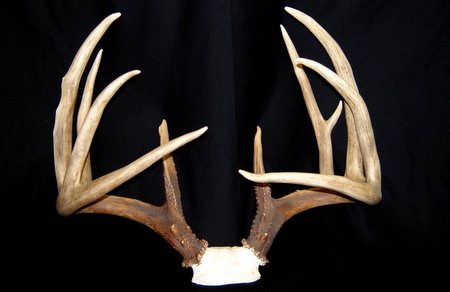Prior articles have discussed normal and abnormal points with regards to deer antlers, but today we are discussing typical and nontypical white-tailed deer antlers. Every set of antlers is classified as typical or nontypical and can be scored as either a typical or non-typical rack. This may sound confusing, but there are advantages to scoring certain sets of antlers one way or the other.
For the purposed of Boone & Crockett Club, typical antlers are those that look like “normal” buck antlers, such as a 10-point buck that has 5-points per side with matched G1s, G2s, G3s, and G4s. Typical means the antlers have antler points in the typical locations where points are found and the conformation on the buck’s rack are typical in nature.

Take, for example, the set of antlers above. Appears to be from a healthy buck, one that most of use would have been more than happy to use a tag on. One of the great things about whitetail bucks is that no two are the same. Some will look “normal” while others fall into the freak show category.
All are unique and rather amazing when you think about it, since antlers are grown and shed year after year. With as many different types of antler configurations out there, antlers are still score only 2 ways when it comes to the Boone & Crockett Club system.

Typical White-tailed Deer Antlers
Nontypical white-tailed buck antlers, on the other hand, are sets of antlers that do not look normal. These can be slightly odd looking, such as having unmatched points (say 4-points on one side and 6 on the other) or can be a totally freakish buck with 34 points going in every direction with points off points.

Nontypical White-tailed Deer Antlers
The most important thing to remember regarding scoring both typical and nontypical antlers is that having a typical, symmetrical frame is very important for the net score. When scoring a typical 8-point, for example, each point is measured and compared to the paired point on the other side of the rack. The left G1 is compared to the right G1, the left G2 to the right G2, and G3 to G3. The difference between in length between G1s is where deductions take place. The same is true for circumferences (H) as well as the main beams.
For the gross score, all the point lengths, inside spread, beam lengths, and circumferences add up for total inches. To get the net score on a typical rack, the differences in paired points, circumferences, and beam lengths are deducted. If all the points are the same length, all the circumferences are the same, and the beams are the same length, the gross and net score will be identical because there are no differences between antler sides, no deductions to be had.
For the gross score on a nontypical white-tailed deer rack, all the point lengths, inside spread, beam lengths, and circumferences add up for total inches. To get the net score on a nontypical rack, the differences in paired points, circumferences, and beam lengths are deducted. Abnormal points still add to the net score on a nontypical rack.

If there is an abnormal point on a typical set of antlers, then that point will be deducted from the net score. Why? Because it is abnormal. It does not matter if it’s a “kicker” off another point or a buck that has 5-points on one side and 6 on the other. Five of the points will be typical because they are matched, but the 6th point will be “abnormal” so to speak. In some cases, good judgement may be needed to properly score your buck and determine which points are normal and paired and which ones are abnormal.